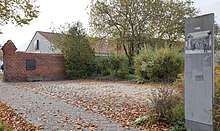Oranienburg concentration camp
Oranienburg was an early German concentration camp, one of the first detention facilities established by the Nazis in the state of Prussia when they gained power in 1933. It held the political opponents of German National Socialist party from the Berlin region, mostly members of the Communist Party of Germany and social-democrats, as well as a number of homosexual men and scores of the so-called undesirables.[1][2]

It was established in the center of the town of Oranienburg on the main road to Berlin when the SA took over a disused brewery grounds. Passers-by were able to look inside the prison perimeter. Prisoners were marched through the town to perform forced labour on behalf of the local council.[1]

The prison was taken over by the SS on 4 July 1934, when the SA was suppressed by the regime. It was closed and subsequently replaced in the area by Sachsenhausen concentration camp in 1936. At closure, the prison had held over 3,000 inmates, of whom 16 had died.
See also
- List of Nazi-German concentration camps
- Standing cell used in Nazi concentration camps during the Third Reich
| Wikimedia Commons has media related to Oranienburg concentration camp. |
References
- BMF (2014). "Oranienburg Concentration Camp 1933–1934". Memorial and Museum Sachsenhausen. Brandenburg Memorials Foundation. Archived from the original on 20 July 2011. Retrieved 17 December 2014.
- Holocaust Encyclopedia (2014). "Oranienburg camp". Concentration Camps, 1933–1939. United States Holocaust Memorial Museum. Retrieved 17 December 2014.
- Meinel, Udo (2007). Memorial and Museum Sachsenhausen (visitor leaflet). Gedenstatte und Museum Sachsenhausen.